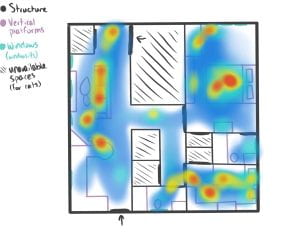Game Instructions (Targeted game experience)
Share images of you and your family featuring your pet over a long period of time. (in this case, my partner and his cat over a 10 year period)
Have the game master (in this case, me) distort the images such that only the pet is clear.
Shuffle the images!
Have the player(s) attempt to reorder the distorted images chronologically.
Finally, reveal the correct order to the player(s).
By Sophie Uldry
Artist’s Statement:
With this last created experimental game experience, I wanted to celebrate cats (and other pets) as family members. Through my journey of involving cats in my art, I have only grown to love and appreciate my cats and their various personalities all the more. I wanted to evoke in my targeted players the nostalgia of past experiences with cats, and share my love for cats with the players. The Family Timeline game I created uses various stages to accomplish this. This game was inspired by artworks created in the way of Appropriation, inspired by the Dada movement’s influence on appropriation, and artists who were inspired by the movement such as Andy Warhol and his borrowing and modifying (appropriating) readymade images of unique American icons. I take existing images, edit them, shuffle them, and use them as the medium for which to provide an experience of nostalgia. Firstly I acquired lots of images from the players, the images need to be scattered over a long period of time and include at least one person with the same cat throughout the years. I chose to make this targeted experience for my partner, so he and his parents looked through albums to find suitable images to share with me. This experience in itself is the biggest point of nostalgia, since it urges the players to look through albums of their past with their pets (in this case, cats). Afterwards, I took a handful of the images given to me and edited them such that the only clear aspect of the images is the cat in each one. Then I shuffled the edited images and asked that the players try to order them chronologically primarily using the cat as a point of reference. Ideally this would be done as a card game, with all of the photo edits laid out in front of the player such that they can clearly look at each of them at the same time. Unfortunately, my playtests were all conducted digitally in the format of a Google Form (available here) such that it was more easily available to the players who were not presently with me. This provided limitations in how I presented the images and how they were answered. I hope to reconduct playtests for this project over the next month to test different edits of images and different playing mediums, because I feel that the game held a lot of potential in portraying my desired messages of pets being a significant part of a family experience, and I can stand to improve this version further. I would also like to note that the form I am sharing is available for anyone to try to play, but obviously won’t accomplish the same results when played by people who both have no history with the pet in question, and did not have an opportunity to relive the nostalgia of searching through photo albums.
Below are the images I used in creating my experience ordered correctly. They are answer keys, please do not inspect if you wish to blindly try Family Timeline via the form shared above!













